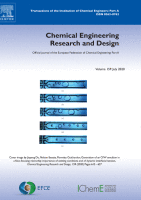 Authors: Licianne P.S. ROSA¹’², Karen V. PONTES², Glória M.N. COSTA¹, Alberto T. PENTEADO², Erik ESCHE², Jens-Uwe REPKE²
Authors: Licianne P.S. ROSA¹’², Karen V. PONTES², Glória M.N. COSTA¹, Alberto T. PENTEADO², Erik ESCHE², Jens-Uwe REPKE²
Affiliations:
¹Industrial Engineering Graduate Program/Federal University of Bahia. Programa de Pós-Graduação em Engenharia Industrial, Escola Politécnica, Universidade Federal da Bahia, Rua Aristides Novis, n° 02, Federação, Salvador 40.210-630 BA, Brazil
²Technische Universität Berlin, Process Dynamics and Operations Group, Straβe des 17. Juni 135, 10623 Berlin, Germany
Reference: Licianne P.S. Rosa, Karen V. Pontes, Glória M.N. Costa, Alberto T. Penteado, Erik Esche, Jens-Uwe Repke, An equation-oriented novel approach for modeling the falling film absorber using rigorous thermodynamic and transport description, Chemical Engineering Research and Design, Volume 159, 2020, Pages 179-194, ISSN 0263-8762, https://doi.org/10.1016/j.cherd.2020.04.006.
Abstract: “Falling liquid films are largely employed in heat and mass transfer processes in a variety of industrial systems, including absorption processes using NH3 and H2O as working fluid. This study develops a new approach based on differential algebraic model for the absorption of NH3 from a gaseous stream by a solution of NH3 and H2O in a falling film absorber at steady-state. Unlike the usual approach in literature, wherein sequential algorithms are specifically tailored to solve the model, the full set of differential algebraic equations (DAE) has been formulated and solved in an equation-oriented fashion. A rigorous modeling of the vapor–liquid equilibrium at the interface is proposed and compared with the usually employed empirical correlations. Thermal and transport properties (TTP) are computed by CAPE-OPEN interfaces, providing robustness and flexibility to the model…”
Comments: this paper describes a falling film absorber model, how it is implemented in MOSAICmodeling in order to be transformed into a MATLAB model and solved there making use of the CAPE-OPEN thermodynamic server TEA for calculating thermodynamic and transport properties (TTP). To enable the CAPE-OPEN function calls in MATLAB, the plug-in “Matlab Thermo Import” from AmsterCHEM is used. The authors point out that CAPE-OPEN “gives further flexibility to the model since the correlations that describe the TTP might be easily changed to better fit the system investigated“. Which is indeed one of the purposes of adopting CAPE-OPEN: use the best adapted model to fit the situation.
